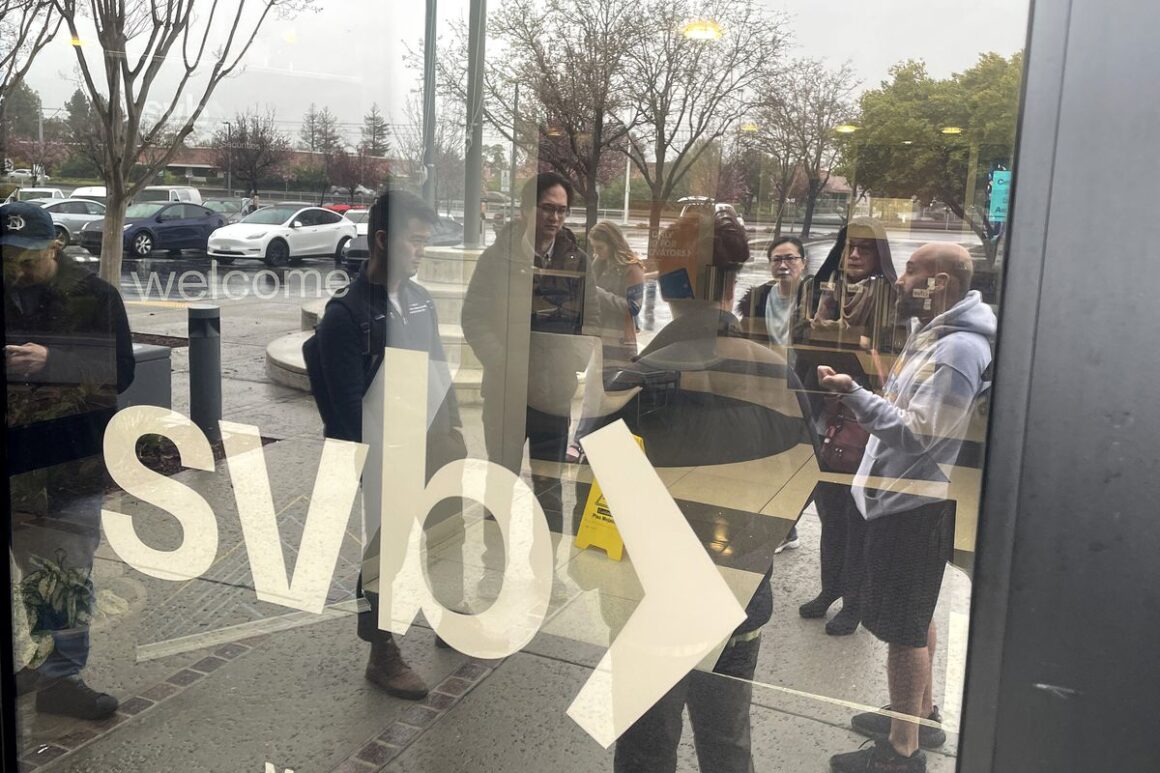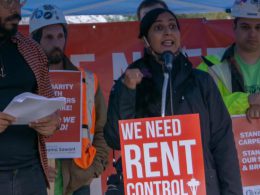By Tom Crean, Socialist Alternative (our sister organisation in the United States)
The collapse of the Silicon Valley Bank last week has opened up a significant financial crisis for U.S. capitalism which now appears to be spreading to Europe. It is too early to say whether this is the beginning of a more full blown crisis that could trigger a deep recession. But at the very least it is exposing the rot that lies just under the surface and all the claims that the economy is “fundamentally sound.”
The Tech Bank
To understand what has happened and what the implications could be for the wider economy, we have to look first at the nature of the Silicon Valley Bank and how events unfolded in recent days. Initial descriptions in the corporate media stressed that SVB is not a “major” bank. This is somewhat deceptive. This is the biggest bank collapse in the U.S. since the 2007–9 crisis. SVB was the 16th largest bank in the U.S. — so definitely not in the same league as the “Big Four,” JP Morgan Chase, Bank of America, Citigroup, and Wells Fargo — but still very big and nominally worth over $200 billion.
More important is that, in the words of the Washington Post, SVB was “the favored bank of tech entrepreneurs and venture capitalists.” It only has 17 branch offices, all of them in California and Massachusetts. Unlike “normal” local, regional, or even national commercial banks, SVB does not have a mix of small depositors and bigger clients. Its depositors were overwhelmingly very rich.
There has been a lot of discussion in the media about the $250,000 FDIC insurance limit. The Federal Deposit Insurance Corporation was established in 1933, at the height of the Depression, with the aim of restoring confidence in the American banking system after the financial collapses in 1929 and 1931. By guaranteeing deposits up to a certain amount, FDIC insurance made it less likely that depositors would panic and seek to all withdraw their money at the same time (a so-called “run” on the banks).
But if we look at SVB, the striking thing is that nearly 90% of the approximately $175 billion (as of December 2022) deposited there was not insured, meaning that the bulk of the accounts were vastly greater than $250,000. This tells you something about the nature of the operation.
How did the collapse happen?
How did the collapse of SVB happen? In the immediate sense, it was the result of its management needing to raise $2.5 billion to cover day-to-day operations. The bank was caught short because of the decline in value of the long-term treasury bonds which formed a key part of their assets.
U.S. treasury bonds are considered an extremely safe asset. However, long-term treasury bonds bought even a couple years ago have declined in real value due to the rapid rise in interest rate. One widely quoted estimate is that, at the end of last year, U.S. banks had $620 billion in “unrealized losses” on such securities. This means precisely that what happened to SVB could happen to others.
When SVB couldn’t raise the $2.5 billion, the value of their shares on the stock market plummeted and investors began a run on the bank. The bank quickly had to close its doors because, like all banks, it only holds a relatively small proportion of the value of its deposits in cash (the rest of the capital is “working,” in this case loaned to all sorts of tech startups).
SVB wasn’t the first bank to fail last week. That honor goes to Silvergate, also California based, and strongly linked to the crypto industry. Over the weekend, another bank in New York, Signature, was also shut by the Federal authorities.
The Feds intervene
The events at Silicon Valley Bank put the FDIC and the Treasury Department into full scale crisis mode last weekend. Their initial goal was to find a buyer for SVB but, not surprisingly, this failed. They then took the extraordinary step of deciding to make the SVB depositors “whole.” This means that the FDIC has guaranteed all the depositors that they will get all their money back. Again, this is not just up to $250,000 per depositor FDIC limit but includes the 90% of uninsured deposits (which could amount to over $150 billion!).
This decision was made because of “systemic risk,” i.e. the danger a whole bunch of other banks would fail if they didn’t act decisively. The Fed said it will offer banks loans “for up to a year in exchange for U.S. Treasury bonds and mortgage-backed securities that have tumbled in value.” (CNN)
The Biden administration is going to great lengths to stress that this is not a bailout. This word of course conjures up how literally trillions of dollars were used to prop up the financial system in 2008–9 while millions of ordinary people lost their homes and jobs.
In one sense this is not a bailout of the type that happened 15 years ago. SVB’s shareholders will not be compensated for the stock whose value has collapsed. Nor, at the moment anyway, are taxpayers footing the bill. The FDIC is using its Deposit Insurance Fund which comes from assessing the banks. But, having committed to covering the full value of deposits at SVB, the FDIC has now effectively guaranteed the full value of deposits in all U.S. banks. Even honouring this commitment at the three failed banks will likely use up a large part of the FDIC fund. They say that they will assess the banks again but if the “contagion” spreads you can be sure finance capital will be looking for a full-blown bailout. In the meantime, they will do everything to pass on the cost to working-class customers with higher bank fees of all sorts.
A number of banks in the U.S. are indeed teetering on the edge with the collapse of bank share values on Monday. Drop in share value does not inevitably mean that a bank will face a run and collapse, but in the current environment this is precisely the concern. For example, the FDIC and JP Morgan Chase intervened directly to backstop one of these banks, First Republic.
On Wednesday, the crisis spread to Europe with the threatened collapse of Credit Suisse, a major bank which had already faced a series of scandals and declining profits. The Swiss National Bank has now intervened to save Credit Suisse but this will not be the end of the crisis.
The end of easy money
The specific problem of “unrealized losses” on bank balance sheets caused by interest rate rises is connected to a wider set of issues.
The solution designed by the U.S. and other capitalist governments to the 2008–9 financial crisis was to pour huge amounts of money into the financial sector, mainly through a mechanism called Quantitative Easing (QE), combined with super low, even negative, interest rates. This has become known as the “era of easy money,” i.e. making money very easily available to the banks and financial institutions.
Normally, printing a whole lot of money should lead to inflation in the wider economy but this did not happen because the capitalists did not broadly invest the money in expanding production. Rather they put it straight back into the financial casino thus “reflating” financial bubbles, as we now see in crypto, tech, and housing.
When the economy collapsed in 2020 due to COVID lockdowns, the Federal Reserve resumed aggressive QE. However, unlike in 2008–9, there were also massive stimulus programs that primarily bailed out big business but also put a non-trivial amount of money into the pockets of ordinary people. The stimulus pumped up demand and combined with supply chain problems to trigger inflation.
In order to address the highest level of inflation in 40 years, the Federal Reserve has since moved in the opposite direction, to a tight money policy, winding down QE and raising interest rates to make borrowing costs higher for companies. The goal — which is not really a secret — is to get companies to start laying people off, thus cutting into aggregate demand and thereby lowering prices. It’s crude and brutal but that’s how capitalism does business.
In the past year, the Fed has raised interest rates from near zero to 4.5%, a tenfold increase and the sharpest and fastest rise since the early 1980s. This is definitely the end of the era of “easy money” and the banking crisis is one of the results.
The measures being taken to address this crisis are inevitably creating new problems as did the measures used to deal with the financial collapse in 2007–09 and the 2020 collapse. But that is inherent in the new era of capitalist disorder where capitalism lurches from crisis to crisis.
Other causes
It is no coincidence that the banks that have collapsed are also directly connected to other currently bursting financial bubbles. All three, especially Silvergate, are linked to crypto which has been imploding for many months. SVB is closely linked to tech where the big firms have already begun large-scale layoffs while there is a “funding frenzy” for AI start-ups from venture capital, a sure sign of a bubble about to burst. SVB’s collapse will directly contribute to the bursting of the tech bubble.
It is also true, as Senator Elizabeth Warren has pointed out, that this crisis is partly the result of undoing the (limited) regulation which was imposed on the banks in the wake of the 2008–9 crisis, particularly the 2010 Dodd-Frank Act. Warren pointed out in a New York Times op ed:
“Wall Street chief executives and their armies of lawyers and lobbyists hated this law. They spent millions trying to defeat it, and, when they lost, spent millions more trying to weaken it.
“Greg Becker, the chief executive of Silicon Valley Bank, was one of the many high-powered executives who lobbied Congress to weaken the law. In 2018, the big banks won. With support from both parties, President Donal Trump signed a law to roll back critical parts of Dodd-Frank.”
Specifically, the kind of “stress tests” and other measures carried out to make sure banks could survive a crisis, were no longer required at banks worth less than $250 billion. So SVB was now far less regulated and able to engage in riskier activity. SVB profits went up to 40%. Days before the crash, SVB executives were selling their stock and literally hours before being shut, they awarded themselves bonuses. They undoubtedly knew the end was coming; we will find out more about their chicanery and corruption over time.
But this isn’t the story of a “bad bank” or just “short-sightedness.” Finance capital constantly pushes for less regulation. And that’s because it is highly profitable for the bankers even if it increases risk for the economy.
Another measure, besides FDIC, passed during the Depression was the Glass Steagall Act which separated commercial and investment banking. This tended to reduce speculative activity and lasted until 1999 when Bill Clinton signed a very bipartisan bill to overturn it at the urging of the big banks. This fuelled an orgy of speculation and profit making in the early 2000s and contributed directly to the 2007–9 crash.
What now?
It is too early to say how deep this current crisis will be. Will the FDIC and Federal Reserve be able to prevent further contagion? They constantly say that this is not 2007–09 and that the banks are basically in better shape. It is broadly true that they are less exposed than they were then, when key banks held huge amounts of “sub-prime” mortgage based derivatives, a type of asset that turned out to be worthless junk.
Nevertheless, the world economy today is in a very fragile position. Among other issues there is a massive debt crisis including both sovereign (national) and corporate debt. Total global debt now stands at an astonishing 350% of GDP.
Now facing a crisis in the banking system, the Fed may hit pause on its campaign to raise interest interests. But this comes as reports that the “core” inflation measure the Fed watches is continuing to go up.
Broadly, despite continued job growth in the U.S., both the U.S. and the world economy is at the edge of another major downturn. The current banking crisis, even if it is contained in the short term, will tend to bring recession closer in the U.S..
But a major global financial crisis which could be detonated for a range of reasons will be far harder for capitalism to manage than in 2007–09 when Obama was able to organize a coordinated response of key capitalist economies, including China. Now with deglobalization and a New Cold War, coordination is far more difficult if not impossible. We saw this graphically during the pandemic when countries refused to coordinate mass distribution of vaccines. In the case of many Western capitalist countries, this looked like outright vaccine hoarding.
And in the end, the capitalists and their political servants in both parties will make the working class pay for the crisis of their system. Look how fast they moved to bail out the rich tech entrepreneurs in stark contrast to the criminal neglect of the people of East Palestine. Their overriding priority will always be the maintenance of profits. We need a system that is based on the needs of working people. This crisis shows why we need to bring the banks, as well as other key sectors, like energy, transportation and healthcare into public ownership under democratic working-class control. Only by creating a socialist economy in the U.S. and worldwide can we prevent senseless crises and begin addressing massive inequality, the crying need for decent education and healthcare, and the impending climate catastrophe.












